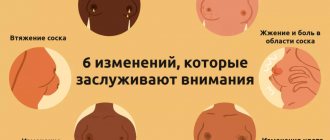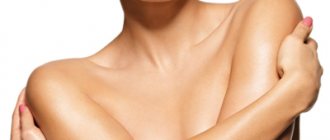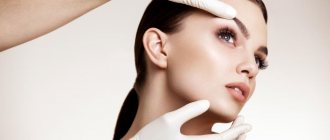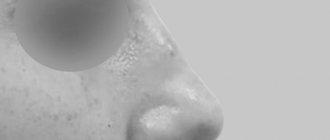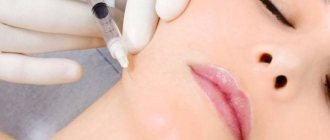According to statistics, this anatomical defect occurs in approximately 2% of the female population of the planet. That is, this disorder is quite common, but doctors know well how to deal with it. Treatment of inverted nipples is often resorted to not for aesthetic reasons, but for medical reasons, since this problem can provoke a number of complications:
- difficulties with nipple and areola hygiene;
- difficulty (and sometimes impossibility) of breastfeeding;
- frequent inflammation of the skin in this area;
- dissatisfaction with one’s own appearance, leading to the emergence of psychological complexes, lack of self-confidence, etc.
Causes of retracted papilla in teenage girls and women
Deviations in the structure of the nipple on the mammary glands in females can be caused by physiological or pathological factors:
| Natural Feature | Pathological deviations |
| Features of breast development (in adolescents). After the formation of the glands, the shape can take on a normal appearance. | Injury to the breasts, especially during their growth. And also poorly performed plastic surgery. |
| Congenital abnormalities in the formation of glands. | Incomplete development of ducts in the mammary glands. It may be a complication from serious illnesses suffered during the period of breast formation. |
| Predisposition at the genetic level (presence of inverted nipples in mother, grandmother, aunt). | Oncological or benign neoplasms in the mammary glands. |
| Tight bra or uncomfortable cups. | Inflammatory processes in the chest (mastitis). |
| Age-related breast sagging. | Tuberculosis of the mammary glands. |
| Rapid breast enlargement during pregnancy or puberty. | Dilation of the milk ducts. The pathology may be accompanied by shortening of the ducts with subsequent retraction of the nipple. |
| Long periods of breastfeeding. | Dermatological pathologies. |
The nipple (inverted) can be on one breast or on both. Physiological and pathological abnormalities are caused by changes in the length of the milk ducts (milk is released through them during feeding), which are connected to the nipple.
Original source of the problem
Content:
- Original source of the problem
- Types of correction
- Alarm Signals
- Surgical approach
- Indications and contraindications
- How is the operation performed?
- Complications and recommendations
Before sending the victim to correct a natural or acquired error, the doctor must first understand the original source of the unusual deviation. Depending on the initial cause of the transformation, the further course of treatment and the choice in favor of a specific adjustment technique will vary.
Often the basis for the pathology is a hereditary form of breast cancer. Women also become victims of inverted nipples due to improper feeding of the child during lactation, or poor breast care at the same time.
Occasionally, wearing incorrectly selected underwear becomes a provocateur of changes. This happens especially often if a representative of the weak of this world likes to wear corrective bras, corsets that are too tight, or underwear chosen that is not the right size.
From a medical point of view, mastopathy can affect the shape and appearance of this part of the breast. It provokes the growth of internal tissues of the mammary gland, which leads to irreversible consequences.
There are also pathologies during puberty. This means that the teenage girl at one time experienced underdevelopment of all standard sexual characteristics. If the body is unable to independently form mammary glands and their ducts, the girl will face a similar aesthetic problem.
The price of the specific procedure, which often involves surgery, varies depending on the severity of the lesion. The need to include funds for the recovery period in the final amount is also taken into account. The doctor’s experience and the clinic’s reputation also play an indirect role in shaping the pricing policy.
But since nipple transformation is a delicate issue, doctors recommend using the services of only proven medical institutions. Also, the cost of manipulation may be affected by the original shape of the elongated nipple. In the medical classification, there are two variants:
- hiding;
- tightly inverted.
The first point provides for the possibility of returning the specified part of the body back as soon as the woman begins to breastfeed. Natural recovery is a fairly common occurrence.
But if you have the second version, which is simply called retracted, you won’t be able to cope on your own. The reason lies in physiological characteristics, since tightly inverted elements never protrude above the surface of the areola at all. Only radical intervention involving plastic surgery can help here.
Symptoms of pathologies
An inverted papilla (the causes in women can be identified by the presence of additional symptoms) is characterized by external changes in the shape of the breast - the nipple is at the level of the areola or retracted inward.
Signs of pathology depend not only on the provoking factor, but also on the severity of the pathology. To determine the degree of retraction, you need to pinch your breast with your fingers (thumb and middle or index finger) in the area near the nipple, at a distance of about 2 cm.
Characteristics of degrees of severity:
- After compression and pressure, the nipple acquires a natural shape and retains it for a short period of time. Next, the nipple again takes on an inverted appearance. This form does not interfere with the natural feeding of the child.
- When manipulating with your fingers, the nipple protrudes with difficulty and immediately retracts back after the procedure is completed. With grade 2, breastfeeding is difficult.
- The nipple does not respond to finger pressure or other irritants. With this form, breastfeeding is impossible.
Checking for the degree of retraction should be carried out on both mammary glands. The procedure is especially important in the presence of “dangerous” symptoms that may characterize the onset of pathology.
Warning signs:
- the nipple retracts and extends without provoking factors;
- redness, swelling and soreness of the peripapillary area;
- the presence of different types of discharge from the nipples (clear, yellowish or purulent liquid);
- peeling or roughening of the peripapillary skin
- pain in the chest along the milk ducts (feeling of breast swelling and heaviness).
A woman should be alarmed by the retraction of juice after piercing, plastic or medical surgery on the breasts (even without the presence of additional signs).
Types of nipple deformities
Inverted nipples are a characteristic feature of a person’s breasts, when they do not protrude above the areola, but are located at the same level with it or are generally “pressed” inside it (sunken).
In their natural state, the nipples protrude above the para-areolar area, approximately 0.5-1 cm. What does an inverted nipple look like? There are two types of nipple deformity:
| Type of retraction | Nature of the anomaly |
| Tightly inverted | Do not protrude beyond the boundaries of the areola. May lead to inflammation and irritation. |
| Hiding | Their independent stretching is observed at the time of feeding the child or stimulation during sex. |
Inverted nipples have three degrees; which one is present can be determined independently. To do this, you need to take off your clothes and stand in front of a large mirror. Supporting the mammary gland along the areola line with your hand, squeeze the breast with the index finger and thumb of the other hand, at a distance of 2.5 cm from the nipple.
Each degree has distinctive features:
| Deformation degree | Characteristics |
| First | With slight pressure on the areola, the nipple protrudes. When the areola is touched, the nipple remains visible for a short period of time and then disappears. Does not cause problems with breastfeeding. The expansion of the connective tissues of the mammary gland is present slightly or absent. |
| Second | The nipples are pulled out only with significant pressure. When released, they immediately tighten back. There may be problems with breastfeeding. Fibrosis is moderate, ductal retraction is slight. |
| Third | The nipple is inside the breast and does not protrude when pressed. Fibrosis and retraction of the milk ducts are significant. There may be manifestations of inflammation and rashes on the chest. Feeding the baby is impossible. |
Consequences and complications
Inverted nipples are not only an aesthetic discomfort.
Pathology may be accompanied by the development of the following complications:
- girls and impressionable women may develop an inferiority complex with subsequent disruption of psychological balance;
- deterioration of sexual desire. The nipple contains erogenous zones that are responsible for sexual arousal, and there is also psychological discomfort. Lack of intimacy can provoke the development of pathologies in the genitals and lead to hormonal imbalance;
- Difficulties with natural feeding and when expressing excess milk. The latter can lead to the development of mastitis;
- accumulation of sweat and dust in small folds formed by the inverted nipple. This can lead to the development of inflammatory processes in the mammary glands;
- soreness of the nipple when it comes out (typical for grades 1 and 2).
Even if the nipple is retracted due to physiological characteristics, it is recommended to undergo examination by a mammologist and, if possible, return the nipples to their natural shape.
What to do with an inverted nipple?
An inverted papilla (the causes in women and girls can only be identified after examination and diagnosis) is not only a cosmetic defect, but also poses a threat to natural feeding and may be a signal of the presence of a disease. Therefore, it is important to promptly identify the nature of the development of the deviation and give the nipple/nipples a natural appearance.
If you have an inverted nipple, you need to perform a self-diagnosis and determine the severity of the pathology. Next, you need to identify the presence of additional symptoms (pain, presence of discharge and condition of the skin on the chest).
After a home examination, a diagnosis from specialists is required to identify the nature of the inverted nipple and determine the method of treatment.
For grades 1 and 2 (with the physiological nature of the development of the deviation), it is possible to eliminate the defect using manual therapy, using special pads or vacuum correctors. In grade 3, the nipple can only be restored to its natural shape through surgery (with and without preserving the possibility of breastfeeding) or piercing.
If the nipple is retracted due to the development of the disease, the shape can recover on its own after the cause is eliminated. It is important that when planning pregnancy with subsequent breastfeeding, the pathology must be eliminated in advance.
Useful video
Watch this video about the surgical technique for correcting inverted nipples:
Similar articles
- Breast ptosis: problem and solutions
Breast ptosis occurs even in young girls. The thing is that many factors influence appearance. You can avoid problems only by eliminating them. Read more - Nipple areola correction: changing shape and size
Correction of the nipple areola is sometimes a forced operation. If you prepare for it correctly and follow the recommendations afterwards, you can avoid many problems Read more
- Stickers on the chest: which ones to choose for lifting, shape...
Using stickers on your chest is stylish and even useful. They are available for tightening, shaping, lifting and supporting, transparent and corrective. Helps with sagging breasts after childbirth. There are disposable and reusable. How to use it correctly? Read more
- Why do a man's nipples peel and the skin around him itch...
Even an experienced doctor will not be able to immediately figure out why the nipples are peeling. The reasons for flaking and itching are different for men and women, and they are also different for a pregnant woman. Read more
Instrumental and other diagnostics of inverted nipple
To determine an inverted nipple, a specialist performs the following examination methods:
- Visual inspection. The pathology is visible to the naked eye.
- Verbal collection of information: the presence of abnormalities in close female relatives, a predisposition to cancer, whether there have been recent injuries or surgical interventions, whether there has been hypothermia of the body (especially the chest).
- Detection of the severity of pathology by palpation.
- Examination of the condition of the lymph nodes in the axillary area.
- Taking tests to identify inflammatory processes and determine the general condition of the body.
- Taking scrapings from the nipple area and discharge (if any).
- To identify tumors and the condition of the milk ducts, diagnostics are used using: X-ray, ultrasound, MRI, color Doppler mapping, CT with contrast agent.
If the development of a malignant tumor is suspected, a test for tumor markers is performed.
Surgical treatment
Surgery to normalize the condition of inverted nipples is required in the following cases:
- non-surgical methods do not give results;
- a woman has stage 3 nipple retraction;
- planning pregnancy with subsequent breastfeeding in the near future;
- removal of tumors (of any nature) is required.
The operation allows the nipples to return to their natural shape in a short time with a low probability of relapse. With therapy without surgical intervention, treatment may take several months, the likelihood of nipple pulling is low, and there is a high risk of the pathology returning.
Preparation
Before surgery, the patient must undergo preparation:
- Undergoing a full examination: identifying the cause of nipple retraction, taking tests, determining the patient’s general condition, excluding contraindications to surgery, determining a possible allergic reaction to anesthetics.
- 5-7 days before surgery, you need to stop drinking alcohol, smoking and certain medications (discussed by the surgeon).
- The last meal should be no later than 14 hours before surgery.
During the preparation period, the doctor voices possible complications and rules of behavior in the postoperative period. The type of operation is also specified (with preservation of the possibility of breastfeeding or without preservation of the functioning of the milk ducts).
How is the operation performed?
Surgical intervention is performed under local or general anesthesia (chosen both at the request of the patient and according to indications). The duration of the procedure is on average 90 minutes.
Surgical treatment of a retracted papilla due to natural causes.
When choosing an operation that preserves the functioning of the milk ducts, a surgical incision is made near the base of the nipple in the areal region. Next, the nipple is lifted and straightened with dissection of the tissues that tighten the nipples and milk ducts. Upon completion, stitches are applied.
The effectiveness of the operation is 75%.
During an operation without preserving the possibility of breastfeeding, a similar dissection is made at the base of the nipple. The short milk ducts and tissues that pull the nipple inward are cut. This allows the nipple to return to its natural shape. Finally, stitches are applied. The effectiveness of surgical intervention is 95%.
Recovery period
Compliance with the rules during the recovery period increases the effectiveness of surgery and minimizes the risk of complications.
For 30 days after surgery you will need:
- protect the peripapillary area from injury and mechanical irritation;
- night rest is allowed only on the back;
- carry out timely disinfection treatments to prevent infection from entering the seam. And also use external and oral medications prescribed by your doctor;
- visiting baths, saunas and other warming procedures are prohibited until the mammary glands are completely restored;
- during the healing period of the suture, it is prohibited to use cosmetic creams on the chest area;
- the bra should be made of natural fabrics and not squeeze the breasts. It is advisable to change it daily;
- do not irritate the nipple and peripapillary area during intimacy. It is recommended to abstain from intimacy for 7 days after surgery. Since sexual caresses provoke stimulation of the nipple, which will worsen the recovery process.
During the recovery period, physical activity is prohibited. If necessary, the doctor will issue a certificate for light work (for the employer). If there is redness in the suture area, fever or severe pain, it is recommended to immediately contact the clinic.
Contraindications
Before choosing surgical nipple restoration, a specialist will diagnose the presence of contraindications:
- poor blood clotting;
- the presence of pathologies in the cardiovascular system;
- age up to 18 years (since the mammary glands are still forming before this age, and the pathology can go away on its own);
- diabetes;
- pregnancy, at any stage;
- presence of oncology (not in the mammary glands);
- dermatological pathologies on the skin of the mammary glands;
- infectious diseases or fever;
- exacerbation of chronic diseases.
The operation is prohibited for patients within 6 months after the end of breastfeeding. Since the milk ducts should return to their natural position.
Possible complications, side effects
If the surgeon’s qualifications are low or the rules are violated during the rehabilitation period, the following complications may develop:
- formation of hematomas at the incision site;
- decreased sensitivity in the operated area;
- scar formation;
- introduction of infection;
- pain in the mammary gland;
- re-retraction of the operated nipple.
Swelling is a normal reaction to surgery.
Surgical approach
Due to the relatively low percentage chance of a successful outcome without recurrence, many patients choose surgery over alternative measures. This procedure is prescribed even to men, although they are extremely rarely treated with such a diagnosis.
Particularly difficult is reconstruction after a mastectomy, when it is necessary to create the nipple almost anew. This requires professionalism and specialist experience. A preliminary detailed consultation will be required to calculate the risks, as well as forecasts of success.
It is important to pay attention to the preliminary stage. The doctor is obliged to study the medical history in detail and also select the ideal anesthesia format. If necessary, an allergy test is performed at the preparatory stage to eliminate the risk of developing anaphylactic shock.
If we are talking about a minor intervention, then it is possible to use local anesthesia. But if the doctor has to work for a long time, restoring tissue at a deep level, then it is better to take advantage of general anesthesia. The patient will also need to undergo a laboratory blood test.
Non-surgical methods. Carrying out corrective procedures
An inverted papilla in women at grades 1 and 2 can be restored using non-surgical methods (for natural causes of the pathology).
Hoffman massage
To carry out the procedure, you need to place your thumbs opposite each other near the nipple. Make opposite movements with them (one finger moves from the nipple, the other to the nipple). Perform manipulations in a circle around the nipple. Initially, perform the procedure 2 times a day with a gradual increase up to 5 times. The duration of therapy is from 6 months to 5 years.
Erotic massage
During intimacy, perform oral caresses of the mammary glands. Additionally, roll the nipples between your thumb and forefinger. To prevent the nipple from quickly retracting, you need to moisten it with cool water. Do the procedures carefully without sudden or painful movements.
Using a breast pump
The device can be used both during breastfeeding and without lactation. To carry out the procedure, it is important to select a flange (silicone pad) of the required diameter (it must completely cover the nipple).
When pulling out the nipple with a breast pump, you need to firmly attach the pad to the breast and select the appropriate operating speed (there should be no painful sensations). Once the nipple is straightened, the procedure is completed.
Using an inverted syringe
To straighten the nipple you will need a 10 cc syringe. To use, you need to cut off the base where the needle should be attached. The piston with handle is inserted from the cut side.
Next, the syringe (with the uncut side) is applied near the nipple and by pulling the piston, the papilla is straightened. Before removing the syringe, you should push the plunger back slightly to relieve pressure and avoid pain.
Application of the Niplette vacuum corrector
The corrector allows you to keep the nipple in its natural state for a long time. The Niplette consists of a small transparent cap that is secured to the nipple with a syringe. To secure the Niplette, you need to lubricate the areola, nipple and base of the cap with a special ointment (indicated in the instructions).
The cap is then connected to the syringe and applied to the nipple. A syringe is used to create a vacuum, which pulls out the nipple. Next, the syringe is disconnected. Start wearing the corrector for 15 minutes with a gradual increase in wearing up to 8 hours.
How to get rid of inverted nipples using nipple formers?
Nipple formers are specialized silicone covers with a hole in the center. The devices are tightly fixed to the chest and maintain the nipple in an excited state.
Accessories not only allow you to gradually return the mammary gland to its natural shape, but also facilitate the process of lactation. It is important to rinse the pads in a timely manner, otherwise contamination of the device will lead to skin irritation and pain.
How to fix it with piercing?
“Earrings” used for piercing do not allow the nipple to retract back. When choosing this method, it is important to choose a proven salon and suitable decoration. The advantage of piercing is the preservation of the possibility of breastfeeding; the procedure takes a short period of time and has a 100% result in straightening the nipple.
Rehabilitation
The rehabilitation period takes on average three weeks. During this time, swelling and hematomas will gradually decrease.
You should refrain from physical activity , sudden and intense movements, as well as hot baths, saunas and solariums for at least a month.
To make rehabilitation easier and faster, you should:
- wear loose T-shirts and T-shirts, and if possible, do not wear a bra. If this is not possible, wear soft underwear that does not compress the chest;
- sleep on your back;
- Follow your doctor's recommendations for caring for your suture.
How to feed a baby with inverted nipples?
An inverted papilla (it is important to identify the causes in women before planning pregnancy) causes discomfort during feeding not only for the mother, but also for the child.
If the pathology was not eliminated before birth, the following methods will facilitate the feeding procedure:
- manual nipple stimulation before feeding;
- using a breast pump;
- the use of specialized overlays that follow the shape of the nipple and stimulate milk production.
Before feeding, it is recommended to express some of the milk, since when the mammary glands are full, the areola is denser, which makes it difficult for the baby to suck. It is also important to choose a position that is comfortable for mother and baby for comfortable feeding.
Methods for eliminating the defect
Methods for correcting inverted nipples are usually divided into two types:
- surgical intervention;
- non-surgical methods.
However, it should be borne in mind that each of these methods is carried out after a medical examination, for a special purpose and strictly under the supervision of a doctor.
Most often, women resort to non-surgical methods in the hope of correcting the situation on their own. However, if the pathology is not congenital, but appeared on its own, this is not recommended.
Treatment and correction method should be prescribed only by a specialist, having previously studied the cause of the deviation.
Exercises
Some of the ways to correct an inverted nipple without surgery include exercises that are recommended to be performed daily for several minutes:
- Compression. The simplest exercise is to squeeze the areola between your index finger and thumb. After this, careful squeezing and unclenching movements are performed. A woman should not experience pain or discomfort in the process of performing these actions.
- Scrolling. For the next stimulation, you will need to lightly pinch the nipple between two fingers and slowly twist it with a not very large radius, first to the left, then to the right. Repeat the procedure several times.
- Pulling back. The nipple is pinched between the fingers and slightly pulled upward. After a few seconds, it is returned to its original position. The exercise is performed for 1-2 minutes on each chest.
When performing these exercises, remember that all movements must be smooth and careful. You should not use force or use sudden movements for this.
Special devices
In addition to physical impact using your hands, there is another mechanical way to correct an inverted nipple. For this purpose special devices are used:
- vacuum nozzles;
- regular breast pump.
Vacuum attachments are small devices that are attached to the nipple. Using a special mechanism, a vacuum is created and the nipple is pulled out.
This device should be used for a maximum of 8 hours a day. Manipulations are carried out over two weeks.
While wearing it, be sure to check the integrity of the nipple and the correct position of the nozzle .
The effect is achieved by stretching the connective tissues and milk ducts that hold the nipple. However, it is worth considering that the achieved result cannot always be maintained for a long period . Most often, the nipple returns almost to its original position over time.
It is also important to stop using vacuum attachments if you experience pain or discomfort.
A similar effect is achieved when using a conventional breast pump. To do this, it is first put on the breast, and then a vacuum is created using a special bulb or button (if the breast pump is electric). After this, it is necessary to press the milk supply hose to maintain the vacuum effect .
The device should be kept in this position for 10 minutes. The procedure should be repeated no more than 10 days in a row.
Let's find out together why a girl has one breast larger than the other and whether the situation can be corrected. In this article, we suggest finding out the real price of a breast lift with threads.
Follow the link https://cosmetolog-expert.ru/plastika-tela/grudi/uvelichenie-g/sobstvennyim-zhirom.html if you are interested in the technique of breast enlargement using fat.
Operation
The surgical operation performed to correct this deviation is divided into two types:
- with an incision of the milk ducts;
- with dissection of connective tissue without damaging the milk ducts.
In the first case, it is important to understand that if this operation is performed, breastfeeding will be impossible in the future. Therefore, this type of correction is carried out only if the woman does not plan to have children in the future or does not intend to use breast milk to feed the baby.
The operation itself lasts about an hour and is carried out in several stages:
- local anesthesia is injected into the nipple area;
- the nipple is pulled back and cut;
- in the lower part the mammary gland separates, pulling the nipple down;
- to prevent it from burning again, the lower part of the tissue is secured with thread;
- a form is created;
- as a result, the nipple has the correct shape and rises above the areola.
With the second correction method, the milk ducts are not affected. However, this does not guarantee that during the operation they will not be damaged by coincidence. Therefore, this method has enough risks for those who plan to breastfeed their baby in the future.
Stages of this type of operation:
- local anesthesia is given in the nipple area and incisions are made on both sides of it;
- fibers that pull inward are separated;
- The shape of the nipple is determined and stitches are applied.
Both types of surgery are performed under local or general anesthesia.
The operation to correct an inverted nipple is presented in the video.
You are 18 years old? If yes, click here to watch the video.
[collapse]
Suitable feeding positions
To facilitate the lactation process (with inverted nipples), the following positions are recommended:
- in a sitting position, place a pillow on your knees and the child on it. The nipple should be near the newborn's mouth. It is important that the position is also comfortable for the mother, since discomfort can provoke additional retraction of the nipple;
- The baby sucks more actively when rocked. To do this, you should walk around the room or rock on your knees;
- Overhang feeding. The child is on a pillow, the mother “hangs” over the child in a half-sitting position. This position facilitates the flow of milk through the milk ducts, making it easier for the newborn to suckle.
Comfortable feeding positions are selected based on the degree of nipple retraction, the amount of milk production and the mother’s imagination. Newborns can adapt to breastfeeding with a shortened or even absent nipple. Lactation stimulates the nipple to return to its natural position. Therefore, it is important to take the right time and help the child adapt.
Using nursing pads
An inverted papilla (natural causes in women are not a reason to refuse breastfeeding) during lactation can be corrected by using specialized overlays. They can be made of latex or silicone (the latter is preferred due to ease of use and durability).
The soft material fits snugly to the mother's breast and completely follows the natural shape of the nipple. Holes in the device (near the nipple and along the edges) allow milk to be released in doses during sucking, and also allow the baby to smell the mother’s smell.
Recommended pads:
| Company name | Device characteristics | Average price (in rubles) |
| AVENT | The pad is made of silicone. The device enhances lactation and reduces discomfort and pain during feeding. | 1100 |
| NUC | Triangular shaped silicone pads. Available in 2 sizes. When used, it stimulates milk production. | 400 |
| Philips Avent | Made from ultra-thin silicone. It has no foreign odors and does not distort the taste of milk. When feeding, stimulates lactation. | 650 |
| Contact | The pads are made of silicone. Convenient for gripping when feeding (for a newborn). They relieve pain in the presence of cracks and prevent injury to the nipple during teething in a child. | 600 |
When choosing a device, it is recommended to obtain a preliminary consultation with a pediatrician.
Effect on breastfeeding
Inverted nipples usually do not become a serious problem when feeding a baby.
While inverted nipples can be challenging, babies can usually feed from them by grasping the areola and pressing it against the roof of their mouth. That is, in most cases, with sunken nipples, women retain the ability to breastfeed.
In addition, it should be noted that nipple stimulation often causes partial nipple release. To achieve this effect, nursing mothers can use a variety of techniques.
Some women find that their inverted nipples begin to emerge gradually during pregnancy and breastfeeding.
What can't you do?
If there is an inverted nipple, a woman should initially undergo a full diagnosis and identify the cause of the deviation. If retraction is a symptom of the development of pathology, then various methods (massages, pads, vacuum devices) will provoke the development of complications from manipulation.
Also, after eliminating the cause, the shape of the nipple can return to its natural shape on its own. All methods of nipple traction are not recommended for use before the age of 18. Before this age, the glands are still developing, and procedures can disrupt the formation and development of the glands.
A retracted papilla is not only a psychological discomfort, but also causes difficulties during the lactation process. To confirm the pathology, you can initially perform a self-diagnosis to determine the degree of nipple retraction.
The final diagnosis, identifying the cause and method of treatment, is determined by the doctor. Manual methods, onlays or surgical treatment are used to eliminate pathology in women.
Author: Kotlyachkova Svetlana
Areola
Sometimes the areolas of the nipples of the mammary gland rise significantly above the mammary gland itself. Or the areolas themselves are large. In such cases, surgery is possible to reduce the areola or eliminate an areola hernia.
Photo of the areola area before and after surgery to eliminate its hernia (2 weeks after surgery). Over time, postoperative scars will become completely invisible.
